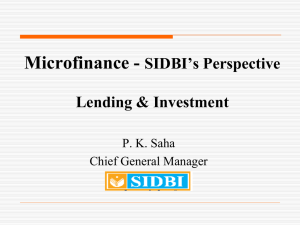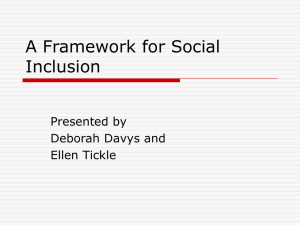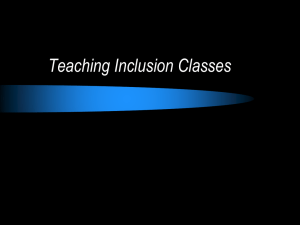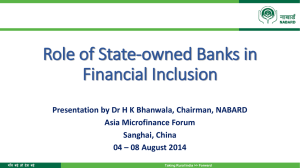Sushil Muhnot, SIDBI
advertisement
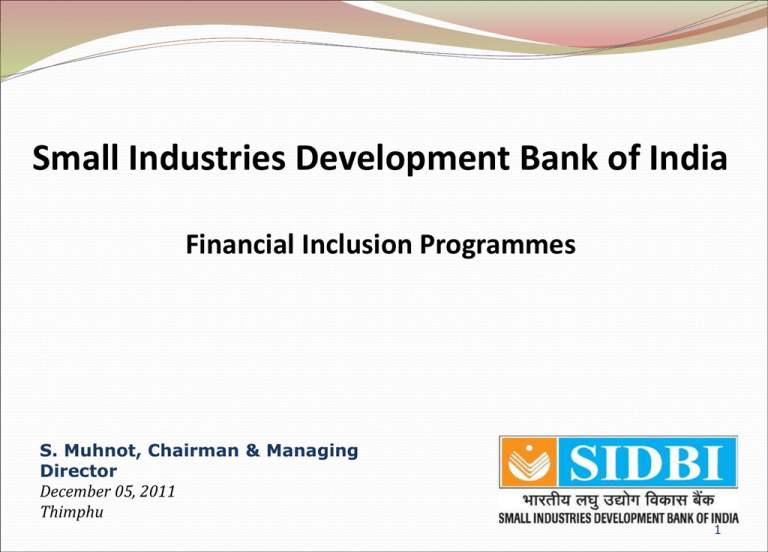
Small Industries Development Bank of India Financial Inclusion Programmes S. Muhnot, Chairman & Managing Director December 05, 2011 Thimphu 1 Financial Inclusion Financial Inclusion is the process of ensuring access to appropriate financial products and services needed by all sections of the society in general and vulnerable groups such as weaker sections and low income groups in particular at an affordable cost in a fair and transparent manner by mainstream institutional players. 2 Financial Inclusion Twin Aspects of Financial Inclusion - Financial Inclusion and Financial Literacy are twin pillars. While Financial Inclusion acts from supply side providing the financial market/services what people demand, Financial Literacy stimulates the demand side – making people aware of what they can demand. Financial Literacy & Financial Inclusion Demand Side Supply Side Financial Literacy & Credit Counseling Centres Credit Absorption Capacity Knowledge of products Need for total products & services Financial Markets , Banks & Services Appropriate Design of products & services 3 Extent of Financial Inclusion -India In India, around half of the country is banked. Approx. 55 per cent of the population have deposit accounts and 9 per cent have credit accounts with banks. There is one bank branch per 14,000 people. Around 20% of the population have life insurance and 9.6% of the population have non‐life insurance coverage. 4 Financial Inclusion – The Indian Way Board approved Financial Inclusion Plans (FIPs) of banks for 3 years, starting April 2010. Roadmap to cover villages of above 2000 population by March 2012 Availability of minimum four banking products through Information Communication Technology (ICT) model has been ensured . Mandatory opening of 25 % of new branches in unbanked rural centers. Know Your Customer (KYC) documentation requirements significantly simplified for small accounts. Pricing for banks totally freed . Interest rates on advances and deposits totally deregulated. 5 Financial Inclusion – Models and Activities Business Facilitator (BF) – NGOs, Farmer Clubs, Community based organisations, Co-operative Societies, Panchayats, IT enabled rural outlets of Co-operative Entities • Identification of borrower • Collection and verification of primary information • Processing and submission of application to banks • Monitoring and Follow-up • Educating about savings, other products, debt counseling Business Correspondent (BC) – Section 25 companies, NBFC not accepting deposit, Post Offices, NGO MFIs under Societies/trusts, MACS All activities of BF + •Collection of small value deposits •Enabling withdrawals •Sale of other financial products •Receipt and delivery of remittances / payment instruments •Disbursal of small value credit and recovery of principal and interest in a limited way 6 Micro Credit as a tool for Financial Inclusion Demand (overall) Potential market: 77 mn. Supply (overall) Two major channels Households Small Industries Development Bank of Estimated annual micro credit India (SIDBI) pioneered Microfinance demand: USD 18 bn to 27 bn. Institutions (MFI) lending channel Demand for other services: USD SHG-Bank Linkage Programme pioneered by National Bank for 2.43 bn. Agriculture and Rural Development (NABARD) These twin channels have total size of around USD 10bn. serving 120 mn clients 7 SIDBI – An Apex Financial Institution Constitution Set up under an Act of Parliament - April 1990 Initially carved out as a wholly owned subsidiary of IDBI Subsequently made autonomous in 2001 Mandate Promotion, financing and development of SSIs (now Micro Small and Medium Enterprises (MSMEs) Co-ordinate the functions of institutions serving the sector. Shareholding Authorized – USD 222 Mn / Paid-up – USD 100 Mn Shares held by 35 GoI owned / controlled Banks and FIs Structure Head office at Lucknow 6 Zonal offices 100 Branches across all the states, catering to 580 clusters 8 Role of SIDBI Supply side Activities – Microfinance • Help transform NGOs/Societies etc. Demand Side – Promotional Developmental Activities & • Enterprise promotion programmes • Skill-cum-Technology to more regulated entities. • Associated with more than 150 Programme MFIs • Introduced the concept of rating of • MFIs • Term loans • Equity / Quasi Equity • Capacity Building Grants Upgradation Cluster Development Programme (CDP) • Entrepreneurship Development Programme (EDPs) 9 Phases of Microfinance Programme of SIDBI - Learning Exploratory Phase Growth Phase Responsible Lending Achievements Achievement Alternate credit delivery channel Successful Implementation of National Microfinance Support Programme Need based products Achievements Lenders Forum Code of conduct assessment Operational & Financial Sustainability of MFIs Capacity Assessment Rating Learning Learning Perceived high risk Need for Capacity Building support Collateral free assistance Learning Need for regulation Transparency Governance Client focused strategies Rope in more stakeholders 10 Promotional & Developmental Initiatives Rural Industries Programme (RIP) Achievement Approach Implementing agencies (IAs) are identified in the districts selected for carrying out RIP. The IA is required to open a field office in the identified district and position one or two facilitators dedicated to the implementation work. The identified provides various professional services necessary including bank linkage for setting up of tiny enterprises. Costs of IA include success fee. Implemented in more than 100 districts in 24 states More than 33000 units promoted; Capital formation - over USD 22 Mn Employment generation -more than 0.1 million persons. Target group -potential entrepreneurs in the rural areas. Focus - value-addition with a view to facilitate promotion of sustainable rural enterprises. 11 Addressing the Missing Middle (> USD 1000 upto USD 20,000) Micro Enterprise Strengthening Downscaling Project to develop tools to assess cash flows of the borrowers who generally do not have formal financial data/information validate such information through cross verification standardize the methodology for use on a larger scale among different categories of borrowers in the segment. The project also developed a credit scoring tool contextualized to the Indian missing middle segment and risk monitoring formats, etc. to monitor the portfolio quality and its performance over a period. 12 SIDBI’s – Umbrella Network One Stop Solution for MSME sector Improve flow of Credit to MSMEs Credit Plus Approach Associate organizationsSpecialized functions Refinance Entrepreneurship / Enterprise promotion SVCL- Venture Capital Structured Products Credit delivery models SMERA- Credit Rating- Green Rating Business Development Services CGTMSE – Credit Guarantee- RSF Missing Middle – Downscaling ISTSL-Technology Transfer-pCDM Direct Credit •Risk Capital •Sustainable Finance Micro finance •Nurturing MFIs ISARC – Asset Reconstruction 13 SIDBI – Products & Services DIRECT FINANCE RISK CAPITAL REFINANCE WORKING CAPITAL FINANCE SIDBI RECEIVABLE FINANCE MICRO CREDIT TECHNOLOGY UPGRADATION, CLUSTER DEVELOPMENT PROMOTIONAL & DEVELOPMENTAL ACTIVITIES 14 THANK YOU 16


